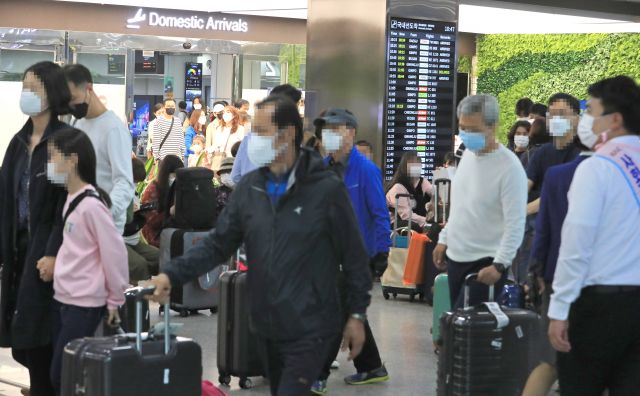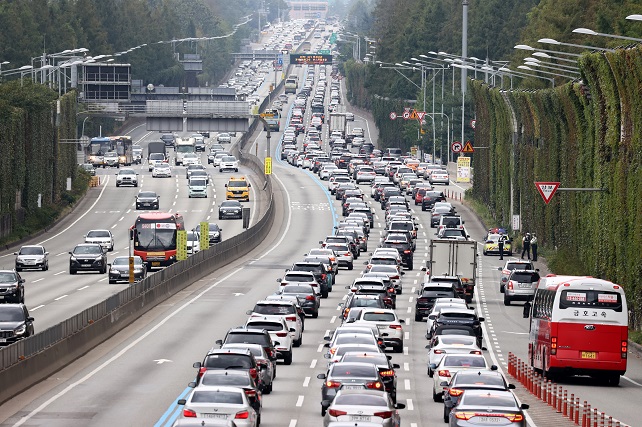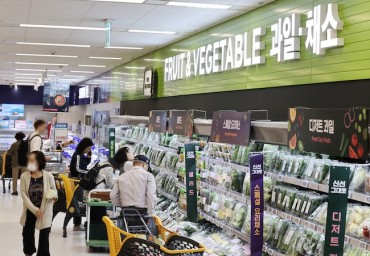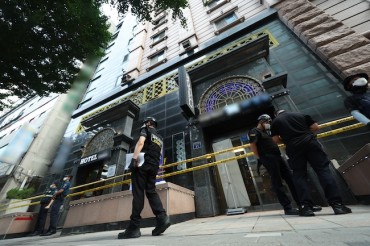
Jeju International Airport is crowded with inbound travelers on the traditional Chuseok autumn harvest holiday on Oct. 1, 2020. (Yonhap)
SEOUL, Oct. 1 (Korea Bizwire) — South Korea’s new coronavirus cases fell below 100 on Thursday, but the country remains on heightened alert for a potential flare-up in transmissions during the extended holiday this week.
The country added 77 more COVID-19 cases, including 67 local infections, bringing the total caseload to 23,889, according to the Korea Disease Control and Prevention Agency (KDCA).
The daily new cases are a sharp drop from the 113 cases reported Wednesday but higher than the 38 registered Tuesday.
As South Koreans take an extended five-day break this week till Sunday, including the traditional Chuseok autumn harvest holiday on Thursday, health authorities are bracing for a potential flare-up of virus infections.
Many people travel across the country to reunite with their families in their hometowns or travel during the autumn holiday.
Except on Wednesday when the daily tally surpassed 100, daily new infections have come down to the double digits since last Saturday as the new wave of mass infections started in mid-August has steadily subsided after peaking at 441 on Aug. 27.
But health authorities have warned that the flattening COVID-19 curve could turn upward again if transmissions during the ongoing Chuseok holiday get out of control.
As a precaution, the government designated the two weeks from Monday to Oct. 11 as a special period requiring extra caution against the spread of the virus.
The country also has a three-day break from Oct. 9 to 11, when Hangeul Day, which celebrates the Korean alphabet, is combined with the weekend.
Tailored Level 2 social distancing requirements will be in place during the special two-week period, banning indoor gatherings of 50 or more people, as well as open-air assemblies of 100 or more people across the country.
Operations of high-risk facilities, such as nightlife establishments, karaoke rooms and sports facilities with intense indoor activities, in Seoul and the greater capital area will be suspended throughout the two weeks.
On Thursday, Seoul added 30 new virus cases, and nearby Gyeonggi Province had 21 new patients, including four imported cases, according to the KDCA.
Other municipalities reported new infections, with the southeastern port city of Busan adding six new cases, Incheon reporting three more infections and North Gyeongsang Province posting five additional patients, the KDCA said.

Gyeongbu Expressway connecting Seoul and Busan, 453 km southeast of the capital, is crowded with cars heading southward on Sept. 30, 2020, one day before the traditional Chuseok autumn harvest holiday. (Yonhap)
Cluster infections, especially those involving medical facilities, continued to expand, putting health authorities on heightened guard.
Dana Hospital, the site of a major infection cluster in recent days, located in the district of Dobong in northern Seoul, added three more cases for a total of 33 COVID-19 patients.
Cases traced to a day care center for the elderly, also in Dobong, rose by two to 32.
Three additional cases were also traced to a health care product sales event in Busan through which 21 people have contracted COVID-19 so far.
Other infection clusters included a medical clinic in Busan, where a total of 10 cases, with one being a medical doctor, had been posted as of noon Thursday.
Of all the cases reported for the past two months, slightly more than 18 percent were transmitted through untraceable sources, down from 19 percent posted a day earlier.
About 31 percent of the new additional cases Thursday involved people in their 60s and above.
The country reported 10 new imported cases, including three from India and two from Uzbekistan, the KDCA said.
South Korea reported two additional deaths, raising the death toll to 415. The fatality rate was 1.74 percent.
The number of seriously or critically ill COVID-19 patients stood at 107, down two from the previous day, according to the authorities.
The total number of people released from quarantine after making full recoveries came to 21,666, up 75 from the previous day.
South Korea has carried out 2,328,435 COVID-19 tests since Jan. 3. The country reported its first case on Jan. 20.
(Yonhap)






